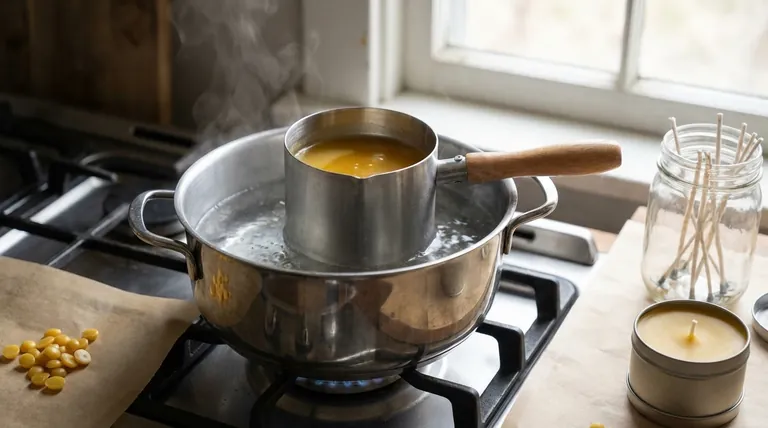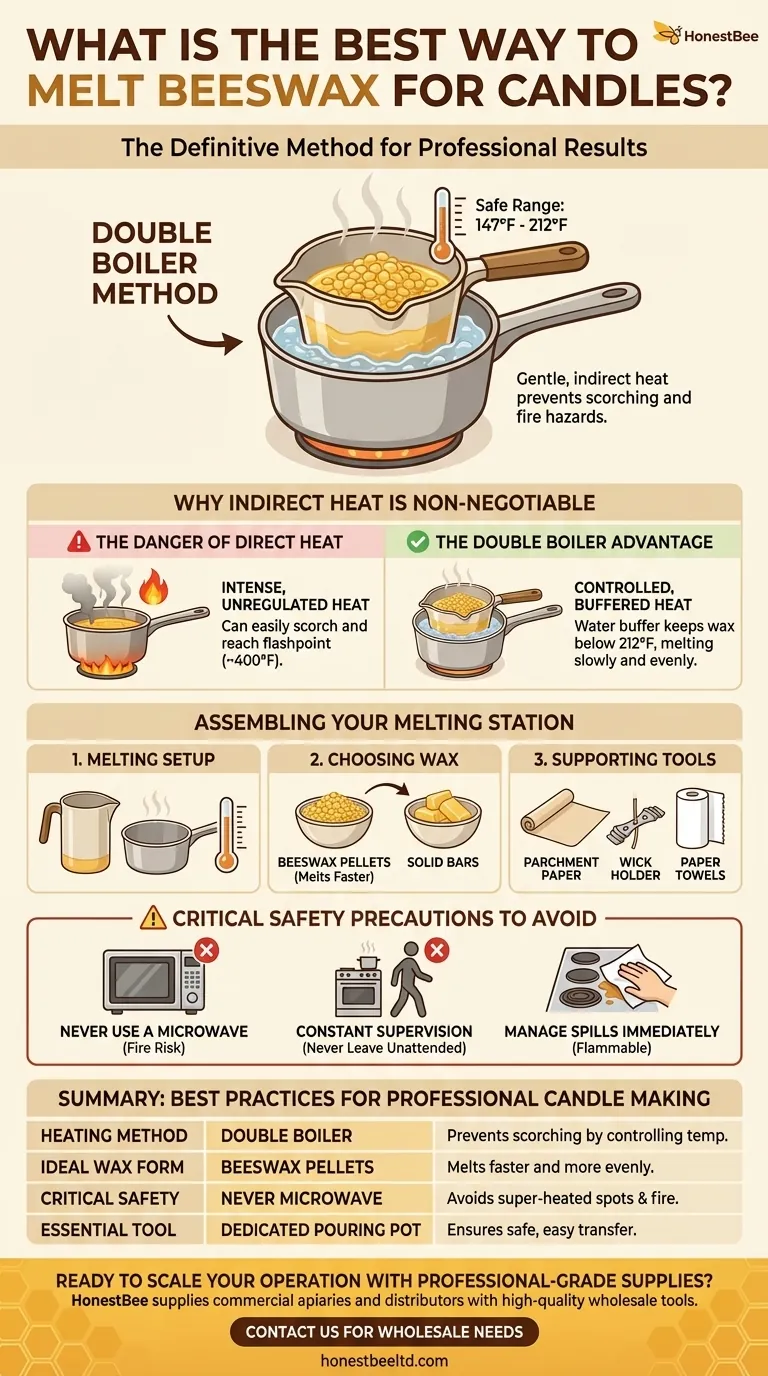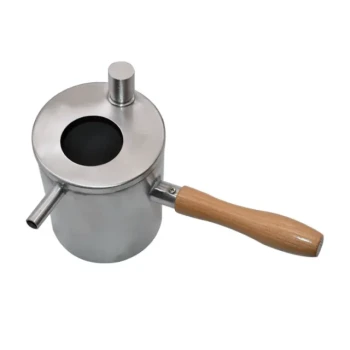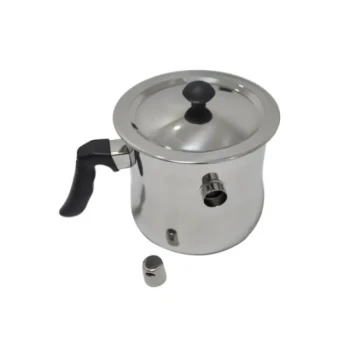The definitive method for melting beeswax for candles is to use a double boiler. This technique involves placing the beeswax in a heat-safe container that sits above, but not touching, a pot of simmering water. This provides gentle, indirect heat, which is the safest and most effective way to melt the wax without scorching it or creating a fire hazard.
The core principle of melting beeswax is control. Direct heat is too intense and dangerous, so the best method uses a buffer of simmering water to slowly and evenly raise the wax to its melting point of approximately 147°F, well below its flashpoint.

Why Indirect Heat is Non-Negotiable
The entire process of candle making hinges on safely melting your primary ingredient. Using the wrong method introduces unnecessary risk and can ruin the quality of your final product.
The Danger of Direct Heat
Beeswax is a natural, but flammable, material. Placing it in a pot directly on a stove burner exposes it to intense, unregulated temperatures.
This can easily overheat the wax, causing it to scorch, smoke, and potentially ignite once it reaches its flashpoint of around 400°F.
The Double Boiler Method Explained
A double boiler provides a crucial layer of temperature control. By heating a pot with only a couple of inches of water, you ensure the container holding the wax never gets hotter than the boiling point of water (212°F).
This gentle, indirect heat melts the beeswax slowly and evenly. You can create a makeshift double boiler with a standard saucepan and a heat-resistant glass bowl or a dedicated pouring pot placed on top.
Maintaining the Ideal Temperature
Beeswax begins to melt at approximately 147°F. The goal is to keep the heat on a medium-low setting, allowing the water to maintain a gentle simmer.
This approach keeps the wax temperature stable and far from dangerous levels, giving you complete control over the melting process.
Assembling Your Melting Station
While the concept is simple, having the right tools makes the process safer and more efficient.
Your Melting Setup
The core of your setup is the double boiler. This can be a dedicated piece of cookware or a simple combination of a large saucepan for the water and a smaller, heat-safe container for the wax.
A dedicated pouring pot with a handle and spout is a worthwhile investment as it makes transferring the hot wax into your candle containers much easier and safer.
Choosing Your Beeswax
Beeswax is commonly available in solid bars or smaller pellets (pastilles). While both work, beeswax pellets will melt significantly faster and more evenly due to their increased surface area.
It is always wise to purchase slightly more wax than you think you will need for your project. Beeswax does not spoil, so any extra can be stored for future use.
Essential Supporting Tools
Protect your workspace with parchment paper or paper towels. Spilled wax is difficult to clean up, especially once it cools.
You will also need a clothespin or pencil to hold the candle wick centered while the wax cools and hardens in its container.
Critical Safety Precautions to Avoid
Candle making is a safe hobby when proper procedures are followed. Ignoring these fundamental safety rules is the most common source of accidents.
Never Use a Microwave
A microwave should never be used to melt beeswax. It heats liquids unevenly, creating super-hot spots that can easily exceed the wax's flashpoint, posing a serious fire risk inside the appliance.
Constant Supervision is Key
Never walk away from melting wax. The process requires your full attention. If you must leave the room, turn off the heat source.
Manage Spills Immediately
Beeswax is flammable. If you spill any wax onto a hot stove or surface, turn off the heat and clean it up immediately and carefully with paper towels to prevent it from igniting.
How to Apply This to Your Project
Your choice of equipment can be adapted based on your commitment and goals, but the principle of indirect heat remains the same.
- If your primary focus is safety and consistency: Use a dedicated pouring pot inside a larger saucepan of simmering water. This is the professional standard for control and easy pouring.
- If your primary focus is trying this out with minimal investment: A heat-resistant glass bowl set over a saucepan of water is perfectly effective and uses common kitchen equipment.
- If your primary focus is speed and efficiency: Always choose beeswax pellets over solid bars. They melt much faster, shortening your preparation time significantly.
Ultimately, mastering the craft of candle making begins with a commitment to a safe and controlled process.
Summary Table:
| Key Consideration | Best Practice | Why It Matters |
|---|---|---|
| Heating Method | Double Boiler (Indirect Heat) | Prevents scorching and fire by controlling temperature. |
| Ideal Wax Form | Beeswax Pellets | Melts faster and more evenly than solid bars. |
| Critical Safety Rule | Never Use a Microwave | Avoids dangerous super-heated spots and fire risk. |
| Essential Tool | Dedicated Pouring Pot | Ensures safe, easy transfer of hot wax into containers. |
Ready to scale your candle-making or beekeeping operation with professional-grade supplies?
At HONESTBEE, we supply commercial apiaries and beekeeping equipment distributors with the high-quality, wholesale-focused tools they need to operate safely and efficiently. From bulk beeswax pellets to durable pouring pots, our equipment is designed for professional results.
Contact our team today to discuss your wholesale supply needs and discover how we can support your business's growth.
Visual Guide

Related Products
- Professional Stainless Steel Wax Melter for Beekeeping and Crafts
- Beeswax Melter for Candle Making Honey Bee Wax Melter
- Steam Beeswax Melter Wax Warmer for Wax Processing
- Electric Beeswax Flat Sheet Machine with Operating Tray for Wax Processing
- Electric Beeswax Foundation Machine With Operating Tray and Wax Foundation Roller
People Also Ask
- What are the safety precautions when working with melted beeswax? Prevent Burns and Fire Hazards
- Can I melt beeswax in a wax melter? The Key to Safe, High-Quality Results
- How long does the wax melting process typically take? A Guide to Safe & Efficient Melting
- What is the flash point of beeswax, and why is it important? Essential Safety Guide for Beekeepers
- How can you monitor the temperature of beeswax as it melts? Ensure Quality & Safety with Precise Control



















